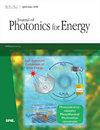Influence of the anode buffer layer materials and the light radiation power on the efficiency of a planar p-i-n perovskite solar cell: theory and simulation
IF 2.1
4区 工程技术
Q4 MATERIALS SCIENCE, MULTIDISCIPLINARY
引用次数: 11
Abstract
Abstract. Planar perovskite solar cell (PSC) measuring 900 nm total thickness is designed and simulated using Silvaco and SCAPS. Silvaco (Atlas 5.16.3.R) photovoltaic simulating system enables the formation of the stacking model and estimation of the physical properties of various functional materials, whereas SCAPS (version. 3.3.07) patterns the photovoltaic metrics including the fill factor (FF), power conversion efficiency (PCE), open-circuit voltage (Voc), short-circuit current density (Jsc), maximum voltage (Vm), maximum current (Im), absorption and reflection coefficients, and energy state diagram of the whole device. Alternation of illumination power and use of different buffer materials was utilized as the main tuning strategy. The champion layout was achieved by optimization of the stacking model, material system, and power of illumination, which demonstrated 26.32% PCE, 83.77% FF, Jsc of 26.27 mA / cm2, and the exceptional Voc of 1.19 V. This theoretical performance remains stable in 1000 W / m2 light radiation. The calculated efficiency and FF were very close to the previously reported experimental data, and this proved the high accuracy of this simulation work. These findings promise a feasible application of PSC in high-efficiency wearable electronics.阳极缓冲层材料和光辐射功率对平面p-i-n钙钛矿太阳能电池效率的影响:理论和模拟
摘要使用Silvaco和SCAPS设计并模拟了总厚度为900nm的平面钙钛矿太阳能电池(PSC)。Silvaco(Atlas 5.16.3.R)光伏模拟系统能够形成堆叠模型并估计各种功能材料的物理特性,而SCAPS(版本3.3.07)则对光伏指标进行建模,包括填充因子(FF)、功率转换效率(PCE)、开路电压(Voc)、短路电流密度(Jsc)、最大电压(Vm),最大电流(Im)、吸收和反射系数以及整个器件的能量状态图。改变照明功率和使用不同的缓冲材料被用作主要的调谐策略。通过优化堆叠模型、材料系统和照明功率,获得了冠军布局,PCE为26.32%,FF为83.77%,Jsc为26.27 毫安 / cm2和1.19V的异常Voc。该理论性能在1000内保持稳定 W / m2光辐射。计算的效率和FF与之前报道的实验数据非常接近,这证明了该模拟工作的高精度。这些发现预示着PSC在高效可穿戴电子产品中的可行应用。
本文章由计算机程序翻译,如有差异,请以英文原文为准。
求助全文
约1分钟内获得全文
求助全文
来源期刊

Journal of Photonics for Energy
MATERIALS SCIENCE, MULTIDISCIPLINARY-OPTICS
CiteScore
3.20
自引率
5.90%
发文量
28
审稿时长
>12 weeks
期刊介绍:
The Journal of Photonics for Energy publishes peer-reviewed papers covering fundamental and applied research areas focused on the applications of photonics for renewable energy harvesting, conversion, storage, distribution, monitoring, consumption, and efficient usage.
 求助内容:
求助内容: 应助结果提醒方式:
应助结果提醒方式:


